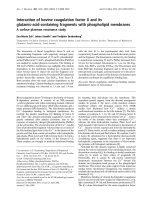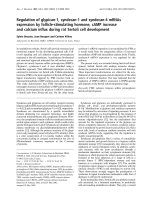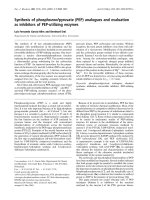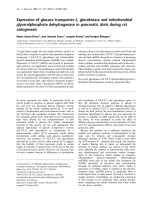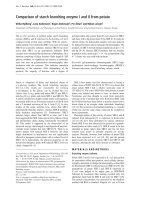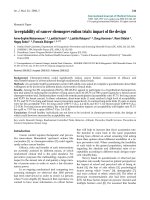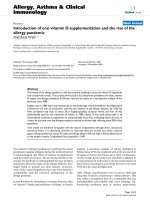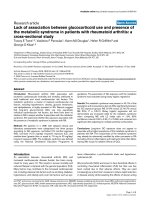Báo cáo y học: " Acceptability of Carraguard, a candidate microbicide and methyl cellulose placebo vaginal gels among HIV-positive women and men in Durban, South Africa" pps
Bạn đang xem bản rút gọn của tài liệu. Xem và tải ngay bản đầy đủ của tài liệu tại đây (263.76 KB, 10 trang )
BioMed Central
Page 1 of 10
(page number not for citation purposes)
AIDS Research and Therapy
Open Access
Research
Acceptability of Carraguard, a candidate microbicide and methyl
cellulose placebo vaginal gels among HIV-positive women and men
in Durban, South Africa
Gita Ramjee*
1
, Neetha S Morar
1
, Sarah Braunstein
2
, Barbara Friedland
2
,
Heidi Jones
2
and Janneke van de Wijgert
2,3
Address:
1
Medical Research Council, P O Box 70380, Overport, 4067, Kwazulu-Natal, South Africa,
2
Population Council, One Dag Hammarskjold
Plaza, New York, New York, 10017, USA and
3
Academic Medical Center, Center for Poverty-related Communicable Diseases, University of
Amsterdam, Meibergdreef 9, PO Box 22700 1100 DE Amsterdam, the Netherlands
Email: Gita Ramjee* - ; Neetha S Morar - ; Sarah Braunstein - ;
Barbara Friedland - ; Heidi Jones - ; Janneke van de
Wijgert -
* Corresponding author
Abstract
Background and Methods: When on the market, microbicides are likely to be used by
individuals who do not know their HIV status. Hence, assessment of safety and acceptability among
HIV positive men and women is important. Acceptability of Carraguard, the Population Council's
lead microbicide candidate was assessed in a Phase I safety study among healthy HIV-positive
sexually abstinent women and men, and sexually active women (20 per group), in Durban, South
Africa. Participants were randomized to use Carraguard gel, placebo gel, or no product. All women
in the gel arms applied 4 ml gel vaginally every evening for 14 intermenstrual days (women in the
sexually active group inserted gel within 1 hour prior to sex on days when sex occurred), and
sexually abstinent men applied gel directly to the penis every evening for 7 days. Acceptability was
assessed by face-to-face structured questionnaires and semi-structured in-depth interviews with all
participants. Gel use questions were applicable to participants in the gel arms only (13 sexually
abstinent women, 14 sexually active women, and 13 abstinent men).
Results: Overall, 93% of the women liked the study gel (Carraguard or placebo) very much, 4%
disliked it somewhat, and 4% were neutral. 15% of men and women disliked the gel's color, smell,
or packaging. Most women and men reported never experiencing pain or irritation during or after
gel application. Although over two thirds of the women preferred some lubrication during sex,
some of the women felt that the gel was frequently too wet. Twenty-one percent of women and
42% of men said they felt covert use of a microbicide would be acceptable. Over 60% of women
and men would prefer to use a microbicide alone instead of using it with a condom.
Conclusion: Acceptability of Carraguard among HIV-positive women and men in Durban was
good. The wetness experienced by the women may be attributed to the delivery of gel volume. The
applicator was designed to deliver 4 mls whereas in fact between 4 ml to 5 mls were actually
dispensed. Condom migration in the event of a partially effective product is of concern.
Published: 27 September 2007
AIDS Research and Therapy 2007, 4:20 doi:10.1186/1742-6405-4-20
Received: 24 July 2007
Accepted: 27 September 2007
This article is available from: />© 2007 Ramjee et al; licensee BioMed Central Ltd.
This is an Open Access article distributed under the terms of the Creative Commons Attribution License ( />),
which permits unrestricted use, distribution, and reproduction in any medium, provided the original work is properly cited.
AIDS Research and Therapy 2007, 4:20 />Page 2 of 10
(page number not for citation purposes)
Background
Vaginal microbicides are products designed to provide
women, particularly those who are unable or unwilling to
use male condoms, with the means to protect themselves
against sexually transmitted infections (STI), including
HIV infection. Since the 1990s, research and development
of microbicides has grown in response to the alarming
rate at which women and girls around the world are
becoming infected with HIV and AIDS, particularly in
resource-limited settings [1,2]. While this new class of
products has the potential to make an important contri-
bution to efforts to curb the spread of HIV/AIDS, the ulti-
mate effectiveness of microbicides will hinge on whether
and how often individuals who are at risk for HIV infec-
tion use them. For this reason, the development of prod-
ucts that are acceptable to users is critical for ensuring that
microbicides achieve their public health objective of pre-
venting new cases of HIV infection.
There is growing consensus in the microbicides field that
the safety and acceptability of promising candidate prod-
ucts should also be evaluated in HIV-infected women and
men [3]. We believe that once on the market, women and
couples may use a microbicide without knowing their HIV
status. Furthermore, HIV positive women and couples
may want to use a microbicide to prevent infection with
other strains of HIV, to prevent acquisition of other sexu-
ally transmitted infections (STI), or to protect their sexual
partner(s) from getting infected. Furthermore, it is impor-
tant for this population to know that this product could
be used by them.
Many microbicide studies are undertaken to assess safety
and acceptability among sexually active and abstinent
women. However there is paucity in the data on safety and
acceptability of the potential microbicides among HIV
positive women and men. The present study was under-
taken to assess the safety and acceptability of Carraguard
among HIV positive sexually active and abstinent women
and sexually abstinent men. The outcome of the safety
paper is published separately [4] whereas the focus of this
paper is on the acceptability of the microbicide in this
population. Given that a phase III trial of Carraguard has
just been completed, it is important to assess acceptability
of the product in diverse population groups to obtain
some information on safety and acceptability.
Methodology
A Phase I randomized, controlled trial was conducted
from May 2002 to July 2003 to evaluate the safety and
acceptability of Carraguard among HIV positive sexually
abstinent men and sexually active and abstinent HIV-pos-
itive women in Durban, South Africa. The study was
designed to assess safety and acceptability among HIV
positive sexually abstinent men and women first to mini-
mize any risk of transmission to sexual partners. This was
followed by assessment of safety and acceptability among
sexually active women. The detailed study methodology
has been published elsewhere [4].
Briefly, HIV-infected women and men were recruited from
clinics, hospitals, and support groups in the Durban area
that provide HIV care and treatment. Women were eligi-
ble if they were aged 18 to 45 years, and were HIV positive
but otherwise in good health as determined by medical
history and physical examination (including CD4+ cell
count > 200 × 10
6
/L and absence of opportunistic infec-
tions, vaginal infections, STI, or genital abnormalities).
Women enrolled into the sexually active study group had
to be sexually active (defined as sexual intercourse at least
twice per week) and willing to have sex with only one
male partner who was also HIV positive, during the study.
Men were eligible to participate if they were aged 18 or
older, were confirmed HIV positive, and were in good
health otherwise (same criteria as women) and were will-
ing to stay sexually abstinent for the duration of their par-
ticipation. Participants were asked to visit the clinic at
screening and after enrollment women returned to the
study clinic for evaluation at Days 7, 14, and 21 (7 days
after cessation of gel use). After enrolment male partici-
pants were seen at day 7 and day 14 (7 days after cessation
of gel use). Procedures followed at each visit are described
in detail elsewhere [4]. All participants provided written
informed consent for study participation at screening and
enrollment. The study was approved by local and Popula-
tion Council ethics review committees.
Sixty participants were enrolled into three study groups
(Figure 1). 20 participants were enrolled in the sexually
abstinent women group; 20 in the sexually active women
group; and 20 in the sexually abstinent men group.
Within each study group, participants were randomized to
one of three study arms: Carraguard, methylcellulose pla-
cebo, or no product (Figure 1). Condoms and safe sex
counselling were provided for participants in all groups at
all study visits.
The sexually inactive cohort was selected because we
wanted to assess the safety in sexually abstinent men and
women first and then in sexually active couples. This
would allow us to ascertain the safety of the product in the
absence of sexual activity which may in itself cause some
epithelial disruption. Although the product is now in
Phase III trial, it was important to assess if there were any
safety concerns among HIV positive individuals. The no
product arm was in the design of the study because the
placebo gel may also cause certain safety outcomes such as
genital findings, thus it was necessary to ascertain safety in
the absence of any product.
AIDS Research and Therapy 2007, 4:20 />Page 3 of 10
(page number not for citation purposes)
At the enrollment visit for women and men, and again at
Day 7 for women, participants who were randomized to a
gel-use group were given a box of 8 single-dose Microlax
®
-
type applicators containing either Carraguard or placebo
(2.5% methylcellulose). Applicators contained 7 ml of gel
each, and were designed to dispense approximately 4 ml
at a single use, however 4–5 ml was dispensed and adher-
ence and acceptability was measured on this volume. All
women were instructed to insert the gel into the vagina
each evening for 14 days; women in the sexually active
group were instructed to use the gel up to 1 hour prior to
sexual intercourse or in the evening on days when sex did
not occur. Men were instructed to apply the gel directly to
the penis each evening for 7 days, and to leave the gel on
overnight. We considered 7 days of exposure to be suffi-
cient as men are only exposed briefly to the gel during sex
and could wipe off the gel immediately after sex unlike
women. Adherence to gel use was measured on the men
and women's compliance to the given instructions
Acceptability of Carraguard and the placebo gel was
assessed both quantitatively and qualitatively for study
participants (Figure 1). Quantitative data on male part-
ners of sexually active women was not collected. Quanti-
tative acceptability data were collected via face-to-face
structured interviews conducted in the local isiZulu lan-
guage by a study team member (Figure 1). Questionnaires
were administered to all participants at the end of the gel-
Randomization scheme and study assessmentsFigure 1
Randomization scheme and study assessments.
1
: Quantitative data: collected by study team member
2
: Qualitative data: collected by external social scientist (within 2 months of the
last visit)
IDI: - In depth interview
Sexually Abstinent Men
N = 20
(13 gel users)
Sexually Abstinent Women
N = 20
(13 gel users)
Carraguard
(
N = 6
)
Carraguard
(
N = 6
)
Carraguard
( N = 7)
Placebo
(
N = 7
)
Placebo
(N = 7)
Placebo
(
N = 7
)
No product
(
N = 7
)
No product
(N = 7)
No product
(N = 6)
Follow-up
Da
y
7
,
14
Follow-up
Da
y
7
,
14
,
21
Follow-up
Da
y
7
,
14
,
21
Sexually Active Women
N = 20
(14 gel users)
60 participants enrolled
Day 7: Questionnaire
1
Post Study: 19 IDI
2
Day 14: Questionnaire
1
Post Study: 17 IDI
2
Day 14: Questionnaire
1
Post study: 19 IDI
2
women, 17 IDI
2
male
AIDS Research and Therapy 2007, 4:20 />Page 4 of 10
(page number not for citation purposes)
use period (Day 14 visit for women and Day 7 visit for
men). The questionnaire contained approximately 70
questions that covered a range of parameters such as par-
ticipants' opinions of product attributes, their experience
of product use, sexual behaviour and preferences, and atti-
tudes toward condoms and vaginal microbicides (Table
1). Furthermore, all participants and the consenting male
partners of women in the sexually active study group were
invited to participate in a semi-structured in-depth inter-
view (IDI) with an external social scientist within two
months of their final study visit. All invited males from
each of the study arms were invited to ascertain their views
of microbicides. Of note is that both hypothetical accept-
ability (for partners of women on no product arm) and
real use acceptability was assessed. All male partners were
consented, and offered voluntary counseling and testing
for HIV. A total of 72 IDI were conducted among: 19 of 20
sexually abstinent men, 17 of 20 sexually abstinent
women, 19 of 20 sexually active women, and 17 of 20
male partners of sexually active women (Figure 1). We
ensured that an external social scientist conducted the
interviews to minimize social desirability. However, this
was only done with male partners of sexually active
women.
Statistical analysis
IDI data were coded by two staff members at the Popula-
tion Council in New York, and analyzed using the
ATLAS.ti
®
software package for qualitative data (ATLAS.ti
GmbH Company, Berlin, Germany). Codes were based
on product characteristics, themes such as influence of gel
use on sexual behaviour, and preferences for HIV/STI pre-
vention methods, including vaginal microbicides. Data
were coded using thematic analysis to assess patterns and
variability in participants' responses to interview ques-
tions.
Quantitative data from the questionnaires were double-
entered into an Access database (Microsoft, Inc., Red-
mond, Washington, USA) and analyzed using the SPSS
statistical software package (SPSS, Inc., Chicago, Illinois,
USA). All participants completed the acceptability ques-
tionnaire.
Results
Our findings showed that there was no difference in the
response between reported acceptability of Carraguard
compared to placebo groups hence combined results of
gel acceptability are thus presented.
Baseline demographics and sexual behavior
The mean age of all enrolled women and men was 29
years (range 19–43) and 32 years (range 21–50) respec-
tively (Table 2). Women had a mean of 12 years of educa-
tion compared to 10 years for men. The majority of
women and men were legally married or in the process of
getting married (defined as some lobola or "bride price"
having been paid), or were in a steady partnership. Ninety
percent of enrolled women reported having given birth in
their lifetime.
The majority of women (78%) reported having had vagi-
nal sex in the month prior to enrollment, with an average
number of 2.7 sex acts in sexually abstinent woman and
5.5 in sexually active women (Table 2). Most women
(81%) reported having used a condom at least once dur-
ing vaginal sex in the month prior to enrollment. Among
men, nearly two thirds (65%) reported having had vaginal
sex in the month prior to enrollment, with an average
number of sex acts of 5.2 (Table 2). More than half of the
men (62%) reported having used a condom at least once
during vaginal sex in the previous month. Almost all
women (93%) and men (80%) had been tested for HIV
Table 1: Acceptability Questionnaire: Parameters and sample questions
Parameter Number of questions Sample question
Gel use experience and product attributes 26 Did the gel dry out too quickly?
Was the gel too wet or drippy?
How did you feel about the amount of gel you had to insert/use each time?
How did you feel about inserting the applicator into your vagina?
How would you rate the study product (gel and applicator) overall?
Covert use of microbicides 2 Do you think women, in general, could use this gel during sex without their
partners' knowledge?
Condom and gel use during sex in study 9 If there were times during the study that you used condoms, what was the
main reason?
On average, how long before sex did you insert the gel?
Sexual preferences 2 Do you prefer sex to be: very dry, dry, somewhat lubricated, very
lubricated, or no preference?
Attitudes toward potential microbicides 26 What kind of microbicides do you think women in your community need?
Would you be more willing to use a microbicide if it protected against both
HIV/STDs and
pregnancy, or only HIV/STDs?
How important is a product that makes your vagina feel clean?
AIDS Research and Therapy 2007, 4:20 />Page 5 of 10
(page number not for citation purposes)
prior to study participation and were aware of their HIV
status at study enrollment.
Overall product rating
In general, participants expressed favorable opinions
about the study product (herein defined as study gel plus
applicator). More than 90% of female and male gel users
reported that they liked the study product overall, and
most of these participants reported that they liked the gel
"very much" (Table 3). Only one sexually active woman
gel user reported disliking the product somewhat as she
felt the gel was cold, preferred the color to be pink and
suggested that the gel be inserted twice a week only rather
than at every sex act. In the context of such favorable rat-
ings of the study product, adherence to product use
among women was 100% and all but one man complied
with product use.
Product characteristics
Participants were asked for their opinions on a range of
gel and applicator characteristics, including the color,
smell, volume and consistency of the gels, and the design
and function of the gel applicator. The following sections
describe participants' responses to particular features of
the study products.
Table 3: Participants' attitudes toward study products
All women (n = 27) Men (n = 13)
Overall study product rating:
• Liked 93% (25/27) 92% (12/13)
• Felt neutral 4% (1/27) 8% (1/13)
• Disliked 4% (1/27) 0
Liked gel's color 89% (24/27) 92% (12/13)
Liked gel's smell 85% (23/27) 69% (9/13)
Liked amount of gel 74% (20/27) 54% (7/13)
Liked gel's packaging 89% (24/27) Not applicable
Liked carrying applicators with you 67% (18/27) 46% (6/13)
Gel ever
1
too wet 67% (18/27) 54% (7/13)
Gel ever too sticky 26% (7/27) 39% (5/13)
Gel ever come out of applicator too quickly 44% (12/27) 62% (8/13)
Gel ever soiled woman's clothes
2
63% (17/27) Not applicable
Prefers lubrication during sex
3
82% (32/39) Not applicable
Gel ever caused pain or irritation while using it 7% (2/27) 0
Gel ever caused pain or irritation after using it 4% (1/27) 0
Women in general could use gel without partner's knowledge 30% (8/27) 54% (7/13)
Woman herself would use gel without partner's knowledge 26% (7/27) Not applicable
Would buy gel to use with spouse/steady partner 100% (27/27) 100% (13/13)
1. Here, "Ever" includes the responses rarely, sometimes, often, almost always, and always.
2. Note: we also asked participants about the gels drying too quickly and being too sticky, and whether the gels came out of the applicator too
slowly. Very few users reported any of these as a problem.
3. All women (N = 39), regardless of randomisation group, were asked this question.
Table 2: Baseline demographics and sexual behavior
Sexually Abstinent women
(n = 20)
Sexually active women
(n = 20)
Sexually abstinent men
(n = 20)
Median age in years (range) 29.5 (19–42) 28 (22–41) 31.5 (21–50)
Mean years of education (range) 12 (6–15) 11.5 (5–14) 10 (4–16)
Married/steady partner 80% (16/20) 100% 90% (18/20)
Ever gave birth 90% (18/20) 90% (18/20) Not applicable
Children with one partner 60% (12/20) 70% (14/20) Not applicable
Median number live births (range) 1.50 (0–5) 1.50 (0–5) Not applicable
Vaginal sex in last month (proportion) 55% (11/20) 100% (20/20) 65% (13/20)
Mean number vaginal sex acts in last month
(range)
2.7 (1–4) 5.5 (1–18) 5.2 (1–30)
Male condom use in last month (proportion) 64% (7/11) 90% (18/20) 62% (8/13)
Mean number lifetime sex partners (range) 3.1 (1–15) 3.2 (1–6) 15.2 (3–90)
Ever tested for HIV (proportion) 85% (17/20) 100% (20/20) 80% (16/20)
AIDS Research and Therapy 2007, 4:20 />Page 6 of 10
(page number not for citation purposes)
Gel characteristics: Smell/color
In general, participants liked the gel's neutral color and
smell. Eighty-nine percent (24/27) of the women and
92% (12/13) of the men reported that they liked the clear
color of the gels (Table 3). In addition, 85% (23/27) of
the women and 69% (9/13) of the men reported that they
liked that the gels were odorless.
Hypothetical acceptability among participants who were
not randomized to a gel-use group expressed a preference
for a product with a neutral color and smell. For example,
one sexually active woman in the no product arm said: "I
think that what should be inserted in the vagina must not have
[a] smell [or] color."
Gel characteristics: Applicator/packaging
Eight-nine percent (24/27) of the women gel users
approved of the products' packaging and applicator.
Gel characteristics: Volume/consistency
Over two thirds of the women gel users liked the amount
of gel the applicator dispensed, with 54% (7/13) of men
in agreement (Table 3). Very few participants felt the gel
was ever too sticky, or that the gel dried too quickly after
application. Many women felt that the gel dispensed very
quickly from the applicator. However, a third of the
women participants felt the gel was too wet during or after
use. This was probably due to larger volume actually dis-
pensed trhough the applicator then expected.
Pain/irritation during or after product use
Very few participants reported experiencing side effects
from the gels, such as pain or irritation during or after gel
use. Only 2 women (7%) reported any pain or irritation
during gel use, and 1 woman (4%) reported pain or irrita-
tion after use; none of the male users experienced side
effects. A woman randomised to Carraguard reported, "I
did not see anything wrong I was expecting that I might get
side effects in the vagina but I did not."
Effects of gel use on sex
Sexually active participants were asked about their experi-
ence of using the gel during sex. In general, their responses
were favorable. All sexually active women gel users
reported they always remembered to use the gel before
sex. Seventy-one percent (10/14) of these participants
reported that the gel made sex more pleasurable and less
painful, with 36% (5/14) reporting that the gel increased
their frequency of sexual intercourse. Their male partners
also had positive feelings about the gel, and many of them
reported a preference for the gel over condoms. Finally,
there was a strong desire for the ideal microbicide to
enhance sexual pleasure for both partners (Table 4).
Timing of gel use and adherence
We did not measure the median timing of gel use in rela-
tion to sex but asked the women if they were able to apply
the gel within an hour prior to sex. However, reported
adherence with gel use was high [4].
Overall, sexually active women reported inserting the gel
on average 61 minutes before sex. Women seemed to
accept that the product was to be used at the time of inter-
course. For example, one sexually active woman in the
placebo group said: "I think it is okay that you insert it when
you are going to have sex." Although women were able in
general to adhere to the timing of gel use, they were not
always able to adhere to gel use as per instruction. This
may reflect the difficulty of controlling the timing of sex
for some women. For example, one sexually active
woman in the Carraguard group said: " [the] instruction
was to apply [the gel] one hour before having sex but it [was]
hard to control it because you don't [know] when can you be
ready for sex."
Male partners were also asked about the timing of gel use
in relation to intercourse during the IDI. Many of the part-
ners seemed to accept the timing of gel use. For example,
one partner of a woman in the placebo group said: "I do
not see time and the manner in which it is applied to be [a]
problem." Other male partners expressed more complex
opinions about the timing of product use. A partner of
another woman in the placebo group said: "it is right if [the
gel] settles first I think [my partner] needs to take sometime
after she has inserted [the gel]. [It] will be better if it can be
like when she is going to have sex in the evening [the woman
can] insert [the gel] in the afternoon maybe three hours
before It must be something that is inserted when we want to
have sex."
Effect on lubrication during sex
The preference for dry sex that has been reported by par-
ticipants in other research studies in sub-Saharan Africa
[5] was not commonly expressed by these participants.
For example, only 18% (7/39) of women expressed a pref-
erence for sex in general to be dry. Further, many partici-
pants felt the ideal microbicide should add some
lubrication during sex, and fewer felt it should dry the
vagina (Table 4). Most women in the sexually active group
(93% or 13/14) felt that the gels did add lubrication dur-
ing sex, and most (70% or 10/14) felt this was an advan-
tage, with a number of participants reporting that the
added lubrication made sex more enjoyable and even less
painful for some. Many of their male partners also felt that
the added lubrication during sex from the gel was an
advantage.
" [The] gel is slippery and it's alright It makes sex enjoyable."
[Sexually active woman, Carraguard]
AIDS Research and Therapy 2007, 4:20 />Page 7 of 10
(page number not for citation purposes)
Covert use and other product use dynamics
The majority of the respondents felt that the product was
easy to use. All of the sexually active women gel users and
11 out of 13 of the sexually abstinent women gel users
said they liked inserting the applicator into their vagina.
Similarly, 10 out of 13 of the sexually abstinent men gel
users (77%) said they liked applying the gel to their penis.
These favorable opinions regarding the ease of gel use
were also expressed during the IDI:
" [The applicator] was all right and it was the right size. It was
neither small nor big You open it and [the gel] becomes
squeezed out easily." [Sexually abstinent woman]
A few respondents did mention during the IDI that they
had difficulty finding a private space for gel use, as
reflected in this participant's comment:
"We got used to [inserting the gel] even while it was difficult
because you have to be alone and avoid many people. [Finding
privacy is] something that is not easy to do." [Sexually absti-
nent woman]
Covert use of a microbicide
In general, relatively few respondents felt that a microbi-
cide could – or should – be used covertly. Twenty-one per-
cent (3/14) of the sexually active women gel users felt that
the gel could be used without women's partners knowing,
but only 14% (2/14) reported that they would use the gel
covertly. Support for covert use was stronger among sexu-
ally abstinent women, with 39% (5/13) saying that
women in general could use the gel without their partner
knowing, and 39% reporting that they would use the gel
covertly. Interestingly, somewhat more men than women
were supportive of covert use of a microbicide, with 42%
(8/19) saying that women in general should be able to use
the gel covertly, and 54% (7/13) saying they felt the gel
could be used by women without their partner knowing.
The majority of women (74%) and men (79%) felt that
the decision to use a microbicide should be made by a
woman and man together.
The need for microbicides
Many of the respondents expressed a strong need for
microbicides as another option for protection from HIV
and potentially other STI. All of the women in the gel-use
groups reported that they would purchase the gel to use
with their husband or steady partner, and all of the men
said they would buy the gel for their wife or steady partner
to use. All male and female participants also said they
would recommend the gel to a friend. Some of their com-
ments during the IDI on this topic included the following:
"My opinion about [using the gel] is [it would be favorable if]
you will be able to talk with your partner knowing each other's
HIV status [and] there is something that can be a protection
measure that will serve as if nothing has happened [to] the
married couple." [Male partner who also participated in sexu-
ally abstinent cohort]
"I wanted to be part of [this research] so as to help the commu-
nity [and] and the people for instance, maybe there is a gel or
something that might arise that will help the people who have
HIV " [Sexually abstinent man]
"It will help in that HIV infected persons won't infect others."
[Sexually active woman, Carraguard]
Participants also discussed the importance of having an
alternative to condoms. For example, one sexually active
woman in the placebo arm said: " [M]ost men do not want
to use condoms and the man I am with right now I am not sure
that I'll be with him for the rest of my life. It may happen that
[I] separate with him and I meet someone who doesn't want
Table 4: Traits of an ideal microbicide
Important
1
for microbicide to: All women (N = 39) Men (N = 19)
Add extra lubrication during sex 69% (27/39) 58% (11/19)
Dry the vagina 41% (16/39) 37% (7/19)
Make the vagina feel warm 90% (35/39) 79% (15/19)
Make the vagina feel tight 67% (26/39) 74% (14/19)
Make your/your partner's vagina feel clean 95% (37/39) 95% (18/19)
Increase your own sexual pleasure 100% (39/39) 84% (16/19)
Increase your partner's sexual pleasure 90% (35/39) 84% (16/19)
Not be noticed by you 90% (35/39) 90% (17/19)
Not be noticed by partner 85% (33/39) 84% (16/19)
Smell good 77% (30/39) 68% (13/19)
Taste good 51% (20/39) 47% (9/19)
1. Here, "Important" combines the responses very important and somewhat important.
AIDS Research and Therapy 2007, 4:20 />Page 8 of 10
(page number not for citation purposes)
condoms and we realize that we love each other, so we can use
the gel if he doesn't want to use condoms. So that's what I liked
about the gel because it can help you if you don't use a condom."
A woman in the no product arm commented: "I will be
happy if [the] gel is successful. It will be better than condoms
because condoms burst at times."
Discussion
In high HIV prevalence and incidence areas where micro-
bicides are likely to be introduced for HIV Prevention, it is
imperative that acceptability of novel technologies is
determined in the population at large. Our study suggests
the need and acceptability of microbicides among those
who are already infected with HIV. The strengths of the
study include: a) that Carraguard is in advanced stages of
clinical testing and so acceptability data are particularly
important; b) it is one of the few studies to assess accept-
ability in a randomised controlled trial in sexually active
and abstinent HIV positive women, and sexually absti-
nent HIV positive men; and c) it adds value to current
knowledge on microbicide acceptability by assessing
acceptability and perceptions based on use of product in
advanced Phase III trials.
From the responses received by both HIV-positive men
and women in the current study regarding the need for
microbicides, it is suggested that irrespective of individual
HIV status, a product such as a microbicide would be pur-
chased, used and accepted by individuals. This study con-
firms favorable acceptability findings from previous
studies among men and women [6,7].
One of the disconcerting findings of this study and other
studies involving men is that we are likely to see condom
migration in the event a microbicide or any other inter-
vention becoming available. Given that many of these
products are unlikely to be 100 % effective, accurate mes-
sages regarding the use of the product with condoms will
need to be emphasized. Behaviour change including pro-
motion of safe sex using condoms will have to be empha-
sized.
Adherence to product use and its coital dependency is an
important issue in ongoing large scale trials. In this short
study, adherence to product use was very good among all
study participants. The study was too short to ascertain
whether this trend would have continued for long-term
use. Of note, however, was that application of the product
within the time-frame of 1 hour prior to sexual inter-
course may not always be achievable and it would be
important to develop products which are longer acting.
While these findings suggest that coital dependency of the
product may not be an issue if the product is easy to use
and acceptable, it is important to bear in mind that some
women are not able to control the timing or terms of sex
and so may have difficulty using a product that requires
use just prior to intercourse. From these data, it appears
that product use would be enhanced if a woman's partner
is aware and accepting of the product as well.
Unlike other studies in sub-Saharan Africa that have
reported a common preference for "dry sex" [8], it appears
that our study population did not have a high desire for
dry sex and that some lubrication provided by the gel was
acceptable. However, it was clear, too, that a significant
number of participants felt the gel caused excessive wet-
ness, and so the volume of gel may have been too much.
While the applicators were designed to deliver 4 ml of gel,
data from earlier studies using the same applicator indi-
cated that 4.5–5.0 ml was the average amount squeezed
out, which may have been why women found the gel to
be too wet [7,9] Despite this concern, participants did
report favorably on the effect of the gel on sex. This is in
line with previous studies that showed that vaginal gel can
enhance sexual pleasure [10,11].
When the need for microbicide products discussions
began in the late 1980's [12] it was strongly believed that
a product that a woman could use covertly was required
to prevent HIV acquisition among women and that
women's empowerment was key to addressing the escalat-
ing HIV infection among women. However, over the
years, it has become increasingly evident in hypothetical
and real-use acceptability studies among both men and
women that covert use may not be desirable for all
women, particularly those in steady relationships. In this
study, less than a third of the women felt that the gel could
be used without a male partner's knowledge, and only
26% of them said they themselves would use the gel cov-
ertly. Interestingly, somewhat more men (around half)
said they thought women should or could use the gel cov-
ertly. However, the majority of the men did respond that
use of the product should be a joint decision, which is in
keeping with other research from South Africa. It is diffi-
cult to pinpoint the precise dynamics underlying these
mixed responses. It is possible that the low preference for
covert use among these individuals reflects the types of
relationships (e.g., steady vs. casual, whether egalitarian,
etc.) they are in. Alternatively, it could be linked to partic-
ipants' other opinions about the gel, for example the feel-
ing that the gel was too wet, which would logically reduce
confidence in being able to use such a product covertly.
Participants' strong desire for an ideal microbicide "not to
be noticed" could also be related to their opinions about
covert use (Table 4). Despite these findings, however, the
possibility to use a microbicide covertly remains an
important option for those who would need it.
AIDS Research and Therapy 2007, 4:20 />Page 9 of 10
(page number not for citation purposes)
While it is desirable to assess acceptability of the gel
among HIV-positive men and their partners, the present
study was limited in that the most comprehensive accept-
ability assessment among men was based on penile appli-
cation of the gel. Men's responses may therefore not
necessarily reflect acceptability during sexual intercourse.
For similar reasons, the sexually abstinent women's
acceptability responses may not be optimal. Furthermore,
findings of this study cannot be generalized to all HIV-
infected populations due to the unique characteristics, for
example clinical status and sexual activity, of this popula-
tion. Thus, while this study provides a snapshot of accept-
ability among HIV-positive men and women in Durban, a
much larger study would be required to generalize accept-
ability outcomes to all HIV-positive individuals.
Conclusion
This study of acceptability of a product that just com-
pleted large scale Phase III testing in South Africa provides
valuable insight into desirable product characteristics
among a select population group where these trials are
conducted. Although these large studies will provide some
information on HIV-negative women's perceptions of
product characteristics, the present study advises on
acceptability among women and men who are already
HIV positive. This is critical as once an effective product is
introduced onto the market, not all potential users are
likely to know their HIV status, and therefore understand-
ing acceptability of such products in all population
groups is important. In general, Carraguard was found to
be acceptable among the HIV-positive women and men in
this study, with very few participants reporting side effects
after use and most expressing generally favorable opin-
ions about the product. However, certain product fea-
tures, most notably gel volume, may require re-
formulation (e.g. higher viscosity) to optimize product
acceptability in certain populations or settings.
List of Abbreviations
HIV Human Immunodeficiency Virus
AIDS Acquired Immune Deficiency Syndrome
IDI In-depth interview
STI Sexually transmitted infections
Competing interests
The author(s) declare that they have no competing inter-
ests.
Authors' contributions
GR was the principle investigator at the MRC for the study
and worked with the Population Council to develop the
protocol and systems for study implementation. She
wrote the paper following data analysis.
NSM was the project leader of the study and wrote the
paper with Prof. Ramjee and Ms. Braunstein. She analyzed
the data and was responsible for data quality. She also
implemented the study and developed SOPs with the
team.
SB was the coordinator of this study at the Population
Council. She helped develop study instruments, monitor
study implementation, analyze the data, and wrote this
paper with Prof. Ramjee and Ms. Morar.
BF worked on the original draft of the protocol, informed
consent forms and study instruments as the first coordina-
tor of this study at the Population Council. She advised on
the qualitative data analysis for the study, and contributed
editorial comments on several versions of this paper.
HJ was the data manager for this study at the Population
Council, and worked on data analysis. She contributed
editorial comments on several versions of this paper.
JvdW was the principle investigator of this study at the
Population Council. She developed the original protocol
and study instruments; oversaw study implementation at
the Population Council; and contributed editorial com-
ments on several versions of this paper.
All authors have read and approved this final manuscript.
Acknowledgements
This publication was made possible through support provided by the Pop-
ulation and Reproductive Health Office, Bureau for Global Health, US
Agency for International Development, under the terms of Award no.
HRN-A-00-99-00010.
The opinions expressed herein are those of the authors and do not neces-
sarily reflect the views of the US Agency for International Development/
Additional support for this study was provided by a grant from the Parthe-
non Trust.
The authors would also like to acknowledge the study participants for their
contribution towards the study, the research team who collected the data
and the Population Council.
References
1. Report on the Global AIDS Epidemic 2006. Joint United
Nations Programme on HIV/AIDS (UNAIDS) and World
Health Organization (WHO), December 2006 [http://
www.unaids.org/en/HIV_data/2006GlobalReport/default.asp]
2. Coggins C, van de Wijgert J: Microbicides to prevent heterosex-
ual transmission of HIV: ten years down the road. In BETA Vol-
ume 15. Issue 2 Spring; 2002:23-28.
3. El-Sadr WM, Mayer KH, Maslankowski L, Hoesley C, Justman J, Gai F,
Mauck C, Absalon J, Morrow K, Massa B, Soto-Torres L, Kwiecien A:
Safety and acceptability of cellulose sulfate as a vaginal
microbicide in HIV-infected women. AIDS 2006,
20(8):1109-16.
Publish with Bio Med Central and every
scientist can read your work free of charge
"BioMed Central will be the most significant development for
disseminating the results of biomedical research in our lifetime."
Sir Paul Nurse, Cancer Research UK
Your research papers will be:
available free of charge to the entire biomedical community
peer reviewed and published immediately upon acceptance
cited in PubMed and archived on PubMed Central
yours — you keep the copyright
Submit your manuscript here:
/>BioMedcentral
AIDS Research and Therapy 2007, 4:20 />Page 10 of 10
(page number not for citation purposes)
4. van de Wijgert Janneke HHM, Braunstein Sarah L, Morar Neetha S,
Jones Heidi E, Madurai Lorna, Evans Strickfaden Tammy T, Moodley
Manivasan, Aboobaker Jamila, Ndlovu Gugulethu, Ferguson Taja M,
Friedland Barbara A, Hart Clyde E, Ramjee Gita: Carraguard Vagi-
nal Gel Safety in HIV positive women and men in South
Africa. JAIDS in press.
5. Bentley ME, Morrow KM, Fullem A, Chesney MA, Horton SD, Rosen-
berg Z, Mayer KH: Acceptability of a novel vaginal microbicide
during a safety trial among low-risk women. Fam Plann Perspect
2000, 32(4):184-188.
6. Ramjee G, Gouws E, Andrews A, Myer L, Weber AE: The accepta-
bility of a vaginal microbicide among South African men. Int
Fam Plan Perspect 2001, 27:164-170.
7. Whitehead SJ, Kilmarx PH, Blanchard K, Manopaiboon C, Chaikum-
mao S, Friedland B, Achalapong J, Wankrairoj M, Mock P, Thanpra-
sertsuk S, Tappero JW: Acceptability of Carraguard vaginal gel
use among Thai couples. AIDS 2006, 20(17):2141-2148. Nov 14
8. Morar NS, Ramjee G, Abdool Karim SS: Vaginal insertion and
douching practices among sex workers at truck stops in
KwaZulu Natal. South African Medical Journal 1998, 88(4):470-470.
9. Coetzee N, Blanchard K, Ellertson C, Hoosen A, Friedland B:
Acceptability and feasibility of Micralax applicators and of
methyl cellulose gel placebo for large-scale clinical trials of
vaginal microbicides. AIDS 2001, 15:1837-1842.
10. Morrow K, Rosen R, Richter L, Emans A, Forbes A, Day J, Morar N,
Maslankowski L, Profy AT, Kelly C, Abdool Karim S, Mayer K: The
acceptability of an investigational vaginal microbicide, PRO
2000 Gel, among women in the context of a phase I clinical
trial. Journal of Women's Health 2003, 12(7):655-666.
11. Mayer KH, Abdool Karrim SS, Kelly C, Maslankowski L, Rees H, Profy
AT, Day J, Welch J, Rosenberg Z: Safety and tolerability of vagi-
nal PRO 2000 gel in sexually active HIV uninfected and absti-
nent HIV infected women. AIDS 2003, 17:321-329.
12. Stein Z: HIV Prevention: The need for methods women can
use. American Journal of Public Health 1990, 80:460-462.

